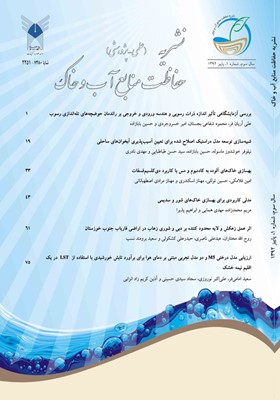مدلی کاربردی برای بهسازی خاکهای شور و سدیمی
محورهای موضوعی : مدیریت آب در مزرعه با هدف بهبود شاخص های مدیریتی آبیاریمریم محمدزاده 1 , مهدی همایی 2 , ابراهیم پذیرا 3
1 - دانشآموخته دکتری؛ دانشگاه آزاد اسلامی؛ واحد علوم وتحقیقات تهران؛ دانشکده کشاورزی و منابع طبیعی؛ گروه خاکشناسی؛ تهران؛ ایران
2 - استاد؛ گروه خاکشناسی؛ دانشکده کشاورزی؛ دانشگاه تربیت مدرس؛ تهران؛ 3360-14115؛ ایران
3 - استاد؛ دانشگاه آزاد اسلامی؛ واحد علوم وتحقیقات تهران؛ دانشکده کشاورزی و منابع طبیعی؛ گروه خاکشناسی؛ تهران؛ ایران
کلید واژه: آبشویی, بهسازی خاک, خاکهای شور و سدیمی, منحنیهای آبشویی,
چکیده مقاله :
مدیریت بهینه خاکهای شور، اهمیتی فراوان در حفاظت درست از منابع آب و خاک دارد. تجمع نمک های محلول در ناحیه رشد ریشه از بزرگترین مشکلات خاک های مناطق خشک و نیمه خشک است. برای غلبه بر این مشکل، آبشویی نمکهای محلول از این خاکها ضروری است. مهم ترین چالش در برنامه های آبشویی، برآورد صحیح مقدار آب مورد نیاز برای اصلاح خاک های شور و شور- سدیمی است. هدف از این پژوهش، ارائه مدلی تجربی برای تعیین مقدار آب آبشویی و مقایسه نتایج با برخی مدل های تجربی موجود بود. بدین منظور، آزمایشهایی صحرایی در منطقه جفیر واقع در جنوب غرب خوزستان با مساحت 21285 هکتار و کلاس شوری و قلیائیت S3A2 انجام گرفت. آبشویی به روش غرقاب متناوب با استفاده از شش استوانه دوگانه در یک آرایش دایره ای شکل انجام پذیرفت. در کلیه آزمایش ها، 100 سانتی متر آب در چهار تناوب 25 سانتی متری به کار برده شد. آب مورد نیاز از رودخانه کارون تأمین شد. چهار مدل ریاضی به داده های مزرعه ای برازش و بهترین مدل بدست آمد. برای منطقه مورد مطالعه، مدل توانی با ضریب تبیین 83/0 و خطای استاندارد 44/0 به عنوان مدل برتر برگزیده شد. نتایج نشان داد که روابط تجربی ارائه شده به وسیله رجب زاده (2009)، هافمن (1980) و لفلار و شارما (1977) با نتایج حاصل از اجرای آزمون های صحرایی، تطابق مناسبی ندارد. روابط ارائه شده به وسیله ریو (1957) و پذیرا و کاواچی (1981)، در مقایسه با مدل نوین ارائه شده در تخمین مقدار آب آبشویی خاک ها دارای بیش برآوردی اندکی بود. روابط ارائه شده به وسیله ورما و گوپتا (1989)، پذیرا و کشاورز (1998)، اسدی و همکاران (2013) و دیلمان (1963) نیز در مقایسه با مدل نوین دارای کم برآوردی اندکی میباشند.
Proper management of saline and sodic soils is essential for optimal conservation of soil and water resources. Accumulation of soluble salts within the root zone is one of the major problems in arid and semi-arid regions. To overcome this problem, leaching of accumulated salts from such soils is necessary. The most important task in leaching practices is assessment of water quantity required for leaching of saline and saline-sodic soils. Therefore, reliable estimation of the required leaching water quantity is vital for reducing soil salinity to a desirable level. The objectives of this study were to introduce an empirical model to account for reclamation water and to compare the obtained results with some available models. Consequently, a large scale field experiment was conducted in jofeir region at south part of west Khuzestan plains, covering an area of 21285 ha with S3A2 salinity-sodicity classes. The intermittent pounding experiment was conducted with six double ring infiltrometers in a circular array. All experiments were accomplished by applying 100 cm of water in four-25 cm intervals. The leaching water was supplied from Karun rive. Four mathematical models were applied to the collected experimental data to derive a suitable empirical model. The results indicated that the proposed power model with maximum correlation coefficient of 0.83 and minimum standard error of 0.44 can provide reasonable estimates for leaching process compares to the previously proposed models. The results indicated that the empirical relations given by Rajabzadeh (2009), Hoffman (1980) and Laffelar and Sharma (1977) can not resemble the field conditions. However, the empirical relationships introduced by Pazira and Kawachi (1981) and Revee (1957) overestimate the depth of reclamation water. The empirical models of Pazira and Keshavarz (1989), Asadi et al., (2013) and Dieleman (1963) underestimated the depth of required reclamation water compares to the newly proposed model.


